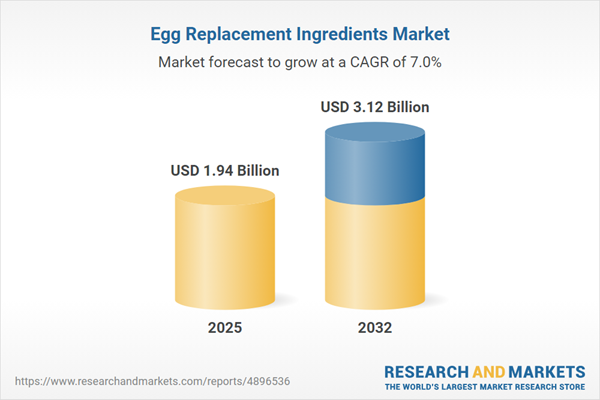Speak directly to the analyst to clarify any post sales queries you may have.
The egg replacement ingredients market is at the forefront of change in the food sector, offering senior decision-makers robust solutions for sustainable product development, improved operational resilience, and effective risk mitigation. As organizations navigate new consumer demands and evolving regulatory frameworks, these ingredients play a pivotal role in addressing longstanding challenges within modern food supply chains.
Market Snapshot: Growth and Trends in the Egg Replacement Ingredients Market
The global egg replacement ingredients market is valued at USD 1.81 billion in 2024, rising to USD 1.94 billion by 2025 and projected to reach USD 3.12 billion by 2032, reflecting a compound annual growth rate of 7.03%. This sector’s robust growth is shaped by focused investment in plant-based product innovation, heightened environmental standards, and the drive for resilient supply chain strategies. Industry leaders are leveraging technology, cultivating partnerships, and evolving operational models to ensure compliance with stricter regulations and address market volatility. In this environment, agility and forward-looking procurement are critical for sustaining a competitive presence and long-term operational success.
Scope & Segmentation: Key Segments, Technologies, and Geographies
- Form: Both liquid and powder formulations enable seamless integration into manufacturing processes, providing food producers with greater flexibility across different product lines and process flows.
- Application: Designed for essential functionalities such as binding, moisture retention, and emulsification, these ingredients ensure consistency in products like bakery items, sauces, dressings, meat substitutes, and confectionery.
- End Use Industry: The market addresses needs of vegan and allergen-free brands, serves foodservice operators implementing dietary trend adaptations, and supports large-scale manufacturers seeking operational efficiency.
- Source: Major sources include pea protein for its adaptability, soy for reliability in functional outcomes, and wheat for providing textural benefits and effective binding, supporting tailored ingredient blends to meet differentiated market needs.
- Geographic Regions: Adoption is advanced in North America and Europe, driven by regulatory policies and strong consumer demand, while uptake is expanding in Asia-Pacific and the Middle East & Africa as supply chains and consumer expectations evolve at the regional level.
- Technologies: Innovations such as precision ingredient fractionation, enzymatic processing, and advanced digital analytics enhance quality control, sustainability evaluations, and traceability—all critical for compliance and end-customer confidence.
- Leading Companies: Prominent providers include Ingredion Incorporated, Cargill, Archer Daniels Midland Company, Kerry Group plc, Roquette Frères S.A., Koninklijke DSM N.V., Novozymes A/S, Corbion N.V., Puris Holdings, and Axiom Foods, Inc., offering both standard and custom solutions to a wide global client base.
Key Takeaways: Strategic Insights for Senior Decision-Makers
- Clean-label initiatives and transparent sourcing practices are becoming integral to maintaining stakeholder trust and complying with changing regulatory demands across markets.
- Adoption of digital production and monitoring systems is essential for protecting product quality and providing agility to meet policy updates.
- Diversification into plant-based and allergen-focused segments supports broader consumer needs and strengthens resilience in product portfolios.
- Advanced development platforms accelerate the introduction of new ingredient formats, supporting organizations in aligning production timelines with emerging trends.
- Collaborative partnerships centered on sustainability and regulatory alignment help mitigate procurement risks and increase reliability within the supply chain.
- Ongoing analysis of market shifts empowers leaders to rapidly implement relevant technologies and stay competitive as industry dynamics evolve.
Tariff Impact: Navigating U.S. Sourcing and Supply Strategies
Recent changes in U.S. agricultural import tariffs are prompting companies to shift focus to domestic and regional protein sources. These measures help ensure stronger supply chain continuity, enhance regulatory compliance, and reinforce stability for stakeholders operating within the egg replacement ingredients market.
Methodology & Data Sources
This analysis draws upon peer-reviewed scientific literature, industry-recognized databases, and proprietary market intelligence. Input from experienced R&D professionals and sector leaders supports the validation of trends and key findings, ensuring that recommendations are grounded in actionable insight relevant for senior executives.
Why This Report Matters
- Delivers frameworks for executives to improve supplier partnerships and introduce greater operational flexibility within food manufacturing and logistics.
- Helps leaders align policy, technology adoption, and risk management strategies with current market and partner ecosystem dynamics.
- Equips organizations with early detection of emerging risks and strategic recommendations to support compliance and long-term planning.
Conclusion
Ongoing advances in ingredient technology, flexible procurement, and process optimization contribute to greater resilience and sustained growth for organizations in the changing egg replacement ingredients market.
Additional Product Information:
- Purchase of this report includes 1 year online access with quarterly updates.
- This report can be updated on request. Please contact our Customer Experience team using the Ask a Question widget on our website.
Table of Contents
3. Executive Summary
4. Market Overview
7. Cumulative Impact of Artificial Intelligence 2025
Companies Mentioned
The companies profiled in this Egg Replacement Ingredients market report include:- Ingredion Incorporated
- Cargill, Incorporated
- Archer Daniels Midland Company
- Kerry Group plc
- Roquette Frères S.A.
- Koninklijke DSM N.V.
- Novozymes A/S
- Corbion N.V.
- Puris Holdings, LLC
- Axiom Foods, Inc.
Table Information
| Report Attribute | Details |
|---|---|
| No. of Pages | 187 |
| Published | October 2025 |
| Forecast Period | 2025 - 2032 |
| Estimated Market Value ( USD | $ 1.94 Billion |
| Forecasted Market Value ( USD | $ 3.12 Billion |
| Compound Annual Growth Rate | 7.0% |
| Regions Covered | Global |
| No. of Companies Mentioned | 11 |









